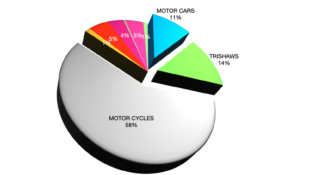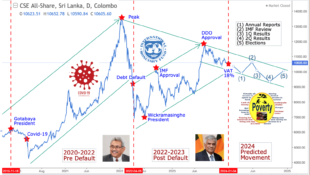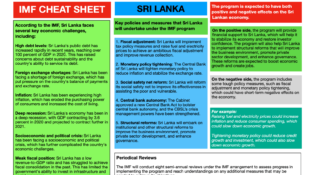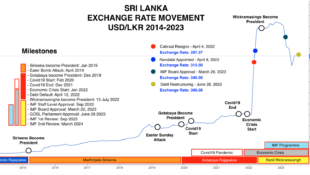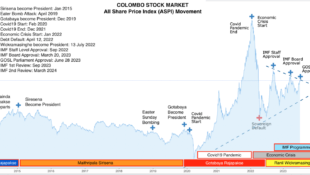2.9 The World Bank classifies Sri Lanka as a lower middle-income country, downgraded from upper middle-income in 2020. Gross Domestic Product (GDP) per capita was USD4,000 (approximately AUD6,000) in 2021. The Western Province is the most prosperous – the Colombo Metropolitan Region generates half of Sri Lanka’s GDP. The services and manufacturing sectors contribute over 90 per cent of total GDP and employ, respectively, 46 and 30 per cent of the labour force. The agriculture sector employs 24 per cent of the labour force and accounts for 8 per cent of GDP. Tourism and remittances are important sources of national income. Although the tourism industry collapsed due to the impact of the COVID-19 pandemic, foreign arrivals have since returned to pre-pandemic levels. Remittances were the equivalent of 6.2 per cent of GDP in 2021, and their value is expected to rise as more Sri Lankans emigrate in search of economic opportunities.
2.10 Sri Lanka’s overall unemployment rate was 5.3 per cent in 2022, although was 26 per cent among those aged 15 to 24. Regional variations in unemployment also exist. The World Bank estimates 500,000 people may have lost their jobs due to Sri Lanka’s economic crisis. Nearly 60 per cent of the labour force was employed in the informal economy in 2021, many of whom lack legal protections and entitlements, including job-linked social benefits.
2.11 Poverty levels have increased significantly since 2020, and inflation and income losses associated with the economy’s collapse in 2022 have deepened Sri Lankans’ economic vulnerability. The World Bank estimates 10 per cent of the population live close to the poverty line.
2.12 According to the World Bank, the poverty rate nearly doubled in 2022 compared to the prior year, to 25.6 per cent, increasing the number of poor by 2.5 million. The World Bank projects poverty levels will remain above 25 per cent in coming years.
Download Full Report: https://www.dfat.gov.au/sites/default/files/country-information-report-sri-lanka.pdf
Economic collapse
2.13 Sri Lanka fell into deep economic crisis in early 2022. Contributory factors included: extensive foreign debt service obligations; low revenue collection (Sri Lanka had one of the lowest tax-to-GDP ratios in the world); a severe contraction in tourism following terrorist attacks in April 2019 and COVID-19 pandemic border closures; a pandemic-induced decline in remittances; rising energy and food prices caused by Russia’s invasion of Ukraine; and the government’s April 2021 decision to ban imports of chemical fertiliser. Sri Lanka’s sovereign credit rating was downgraded in 2020, on the basis that cuts to income and value-added tax would hamper the government’s ability to repay its debts. Having lost access to international capital markets, the government relied on foreign exchange reserves to service its external debt obligations and pay for essential imports, leading to a precipitous drop in reserves. According to the government, it had USD25 million in usable foreign reserves in June 2022, down from USD7.5 billion in November 2019.
2.14 Lacking foreign currency to pay for imports, Sri Lanka experienced severe shortages of necessities, including fuel, cooking gas, electricity and medicine, and experienced power cuts of up to 13 hours a day. These shortages and a collapsing currency drove record levels of inflation (70 per cent in September 2022, higher for food and fuel), making essential items, if available, out of reach for many Sri Lankans. In May 2022, Sri Lanka ran out of petrol and the government reported the economy ‘completely collapsed’. Sri Lanka also defaulted on its sovereign debt for the first time and sought assistance from the International Monetary Fund (IMF). The IMF approved a four-year, USD2.9 billion rescue package in March 2023. As a condition of the IMF’s support and those of its foreign creditors, Sri Lanka is implementing structural reforms and fiscal austerity measures, including raising taxes and reducing spending.
2.15 The economic crisis caused significant humanitarian hardship, deepened poverty and created a cohort of newly poor. In March 2023, 5.7 million people needed humanitarian assistance. According to World Bank estimates, 75 per cent of households experienced contractions in income due to livelihood disruptions and diminished opportunities for income generation. In parallel, inflation eroded peoples’ purchasing power, creating unprecedented cost-of-living pressures.
2.16 Food inflation reached 93.7 per cent in August 2022, making basic food items prohibitively expensive for low-income earners. The Food Security Information Network categorised Sri Lanka as being in a major food crisis for the first time in 2022. In January 2023, the World Food Programme (WFP) found 30 per cent of Sri Lankans were food insecure, with 60 per cent of households reducing their food consumption, eating cheaper and less nutritious food or skipping meals altogether. Households in Uva (47 per cent) and Sabaragamuwa (39 per cent) provinces recorded the highest levels of food insecurity in January 2023, with the Western Province (23 per cent) the lowest. As of August 2023, nearly half of all children were undernourished, with one in five suffering from wasting. According to in-country sources, some households withdrew children from school, migrated to other locations in search of employment, sold houses or land, pawned belongings and/or ran down savings as coping strategies.
2.17 In-country sources told DFAT the economic situation had stabilised since 2022 and reported: essential items were available; inflation was in single digits; the rupee had appreciated; and power cuts had ended. With recoveries in exports, tourism and remittances, foreign exchange reserves have increased, and the government’s deal with the IMF has unlocked additional funding from the World Bank and other multilateral lenders. Nevertheless, cost-of-living pressures remain pronounced, particularly for low-income households, and general living standards have declined. Austerity measures were aggravating these pressures, for example, electricity prices had increased more than 140 per cent since August 2022. According to the Ceylon Electricity Board, over 500,000 customers had been disconnected from the power grid after failing to pay their bills. While the acute crisis was over, economic conditions remained challenging and the recovery process will likely be long. According to the World Bank, Sri Lanka’s economy contracted by 2.3 per cent in 2023, and as at April 2024 was projected to return moderate growth (2.2 per cent) in 2024, showing signs of stabilisation following severe economic downturn in 2022.
2.18 In-country sources reported that outward migration held growing appeal for Sri Lankans across all communities and socioeconomic classes. According to official statistics, over 600,000 Sri Lankans left for foreign employment via legal pathways in 2022 and 2023, amid economic instability and diminished living standards. Most are low- and semi-skilled workers who have moved to the Middle East; however, they also include significant, growing numbers of skilled professionals, including doctors, nurses, IT engineers and academics (see also Health and Education). In-country sources reported that 2,000 public servants had also left Sri Lanka in the first six months of 2023. The government incentivised people to temporarily move abroad to increase remittances, although subsequently reversed such policies amid growing concern about ‘brain drain’. In-country sources reported that the brain drain posed risk to Sri Lanka’s future growth potential. In-country sources told DFAT that, regardless of ethnicity, economic conditions were the primary concern of Sri Lankans and the main reason people wanted to leave the country.
2.19 DFAT assesses that economic conditions have deteriorated since the 2021 publication of this report, and are the main push factor for emigration across Sri Lanka.
Economic conditions in the north and east
2.20 Agriculture and fishing predominate in the largely rural economies of the north and east; in Jaffna, agriculture accounts for over 60 per cent of people’s livelihoods. Economic conditions have improved in the post-war period, albeit from a low base, and these provinces remain less developed than the rest of the country. Unemployment is higher than the national average, and household incomes lower; Mullaitivu and Kilinochchi districts in the Northern Province are the poorest in Sri Lanka (57 per cent of the population in Mullaitivu District live in poverty). Many households rely on remittances from relatives in the diaspora to meet living costs.
2.21 The impacts of the economic crisis were keenly felt in the north-east, including in the form of shortages of essential items and lengthy power outages (sometimes only four hours of electricity a day). In- country sources reported these pressures had subsided, although cost-of-living and austerity measures continued to weigh heavily on households. As one manifestation of these pressures, in the first half of 2022, 246 children were handed over by their parents to child development centres in the Northern Province, a significant increase from 158 in 2021. Fuel and food prices remained elevated in June 2023, and in country- sources reported accounts of people skipping meals. According to in-country sources, businesses in the north-east were not investing, and the construction sector had contracted, reducing opportunities for daily wage work. Some in-country Tamil sources told DFAT the economy, not human rights, was Tamils’ core concern today.
2.22 In-country sources reported that community-level resilience built during and after the civil war had helped mitigate the full impact of the economic crisis to some extent, as people were used to hardship. Unlike in the south, shortages were not new, and community-based collectives and other forms of locally led economic safety nets were more established. Remittances from the Tamil diaspora also helped cushion the impact, particularly in Jaffna. Agriculture for self-consumption provided another safety net. A WFP household survey conducted in January 2023 found 26 per cent of Northern Province households were food insecure, compared to 35 per cent in the Eastern Province.
2.23 The military, with no active defence role since May 2009, was economically active in the north-east. The military was primarily engaged in farming, but operated in other sectors, too, including construction and hospitality, and reportedly ran pre-schools. In-country sources said the military’s economic activities were distorting local markets and displacing the regular economy, depriving civilians of employment opportunities and eroding community trust. According to in-country Tamil sources, the military employed former LTTE members, primarily women, on its farms. UN special procedures have consistently called on the government to end the military’s involvement in the economy.
2.24 In-country sources told DFAT there were high levels of indebtedness in the north-east, fuelled by uptake of high interest loans from microfinance companies. Microfinance companies have been highly active in these regions in the post-war period, particularly since 2014, often lending at exorbitant interest rates and targeting vulnerable households, including female-headed households. In-country sources described the practices of some microfinance companies as ‘unscrupulous’ and ‘debt traps’. The Sirisena Government imposed a 35 per cent cap on microfinance loans and provided relief to some borrowers, and the current government plans to introduce a Credit Regulatory Authority Bill to better control the industry. Registered microfinance companies operate legally; the Microfinance Act (2016) regulates their operations. In-country sources attributed many suicides in Jaffna to an inability to repay debts.
2.25 DFAT assesses that Sri Lanka’s economic crisis has aggravated already-challenging economic conditions in the north-east, which are the primary driver for migration – internal and external, legal and illegal – from these regions.
Loan sharks
2.26 ‘Loan sharks’ (informal, unlicensed money lenders) are known to operate in Sri Lanka, including in Colombo and Jaffna. In-country sources could not speak to their prevalence. Less reputable microfinance companies lending with high interest rates were often equated with loan sharks (see Economic conditions in the north and east).
2.27 In-country sources told DFAT that informal, high interest loans were easy to obtain in Jaffna, and illegal money lending had increased in recent years. In-country sources said that informal money lenders operated in villages, however the ‘predatory practices’ of microfinance companies were a bigger concern. People unable to access formal banking facilities, those with no or poor credit histories, and people in urgent need of cash were most likely to seek loans from informal lenders.
2.28 In-country sources reported that loan sharks employed gangs to help with debt recovery in the north, and said violence was used in some instances. In Colombo, loan sharks have required a surety (for example, property deeds, vehicles, gold or jewellery) and family details in the event of default. Loan sharks were reported to maintain strong regional networks, capable of locating absconders.
2.29 In-country sources told DFAT that, while it was theoretically possible for victims of loan sharks to seek state protection, this was difficult in practice, as loan sharks and gangs were powerful and could influence the police. Some local media outlets have reported that loan sharks also have links to politicians.
Download Full Report: https://www.dfat.gov.au/sites/default/files/country-information-report-sri-lanka.pdf
 would enable you to enjoy an array of other services such as Member Rankings, User Groups, Own Posts & Profile, Exclusive Research, Live Chat Box etc..
would enable you to enjoy an array of other services such as Member Rankings, User Groups, Own Posts & Profile, Exclusive Research, Live Chat Box etc.. 
 Home
Home











